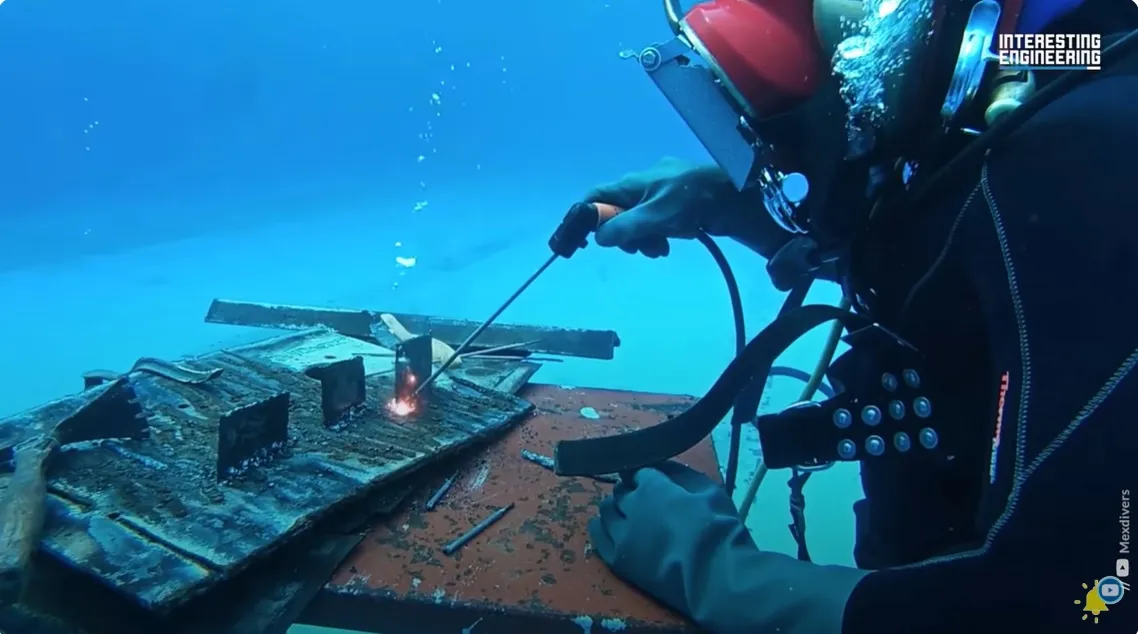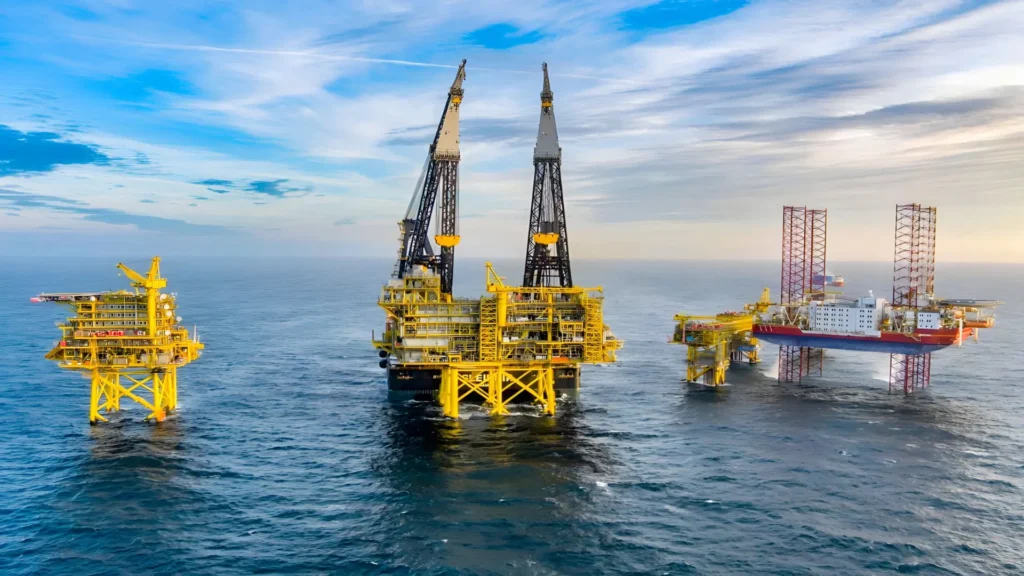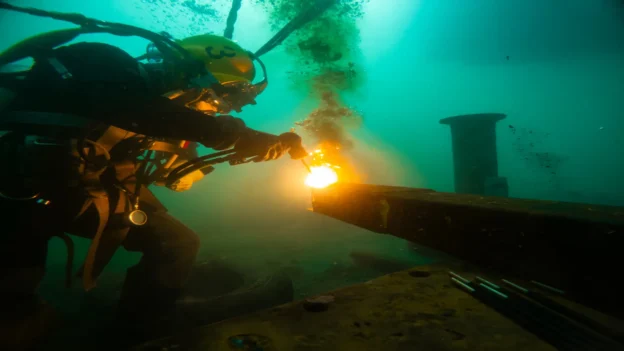Table of Contents
- What is underwater welding?
- Underwater welding techniques
- Underwater welder training and certification
- Risks and hazards of underwater welding
- Lessons learned: Deepwater Horizon
- Salary and career prospects
- Underwater Welds
- Industrial applications of underwater welding
- Trends and innovations in underwater welding
- Challenges of deep welding for the future
- Success stories
- Conclusions
- References
- Frequently Asked Questions (FAQs)
- How much does an underwater welder earn on average, and what are the job prospects?
- What are the main risks of underwater welding and how are they managed?
- What certifications and training are required to become a professional underwater welder?
- What is the difference in quality between wet welding and dry welding?
- How are robotics and AI impacting underwater welding safety?
Underwater welding is a fundamental process for the integrity of marine and offshore infrastructure. From oil platforms to submarine pipelines and ships, this type of underwater welding allows critical repairs to be carried out without having to bring structures to the surface, saving time and costs and ensuring the structural integrity and reliability of assets in highly complex environments.
This article explores the main underwater welding techniques, risks, training, salaries, weld quality, industrial applications, emerging trends, technological innovations, and future challenges, anticipating the most frequently asked questions in the sector.
What is underwater welding?
Also known as hyperbaric welding, this is an advanced technique used to join metals underwater by applying heat or pressure. This process is crucial for the construction and repair of underwater structures such as pipelines, oil platforms, and ships. This type of welding can be performed in two ways: wet welding and dry welding.
Wet Welding
Wet welding is performed directly underwater using specialized equipment, such as electrodes coated with waterproof material. These electrodes generate an electric arc underwater, which melts the metals and allows them to be joined together.
- Advantages: This method is faster and cheaper than dry welding, making it suitable for urgent tasks or those with a smaller budget.
- Disadvantages: The quality of the joints is inferior, as factors such as water pressure, sea currents, and temperature can affect the electric arc. This increases the risk to the welder’s safety.
Dry Welding (or Hyperbaric Chamber)
Dry welding is performed in a pressurized chamber that isolates the work area from water. This dry environment creates conditions similar to those of terrestrial welding, allowing the welder to use the same equipment and techniques as on land.
- Advantages: Dry welding offers higher quality and safety compared to wet welding. Joints made in a dry environment are more durable and resistant.
- Disadvantages: This technique requires a more complex and costly infrastructure, which increases both costs and execution time.
In the welding field, underwater welding is one of the biggest challenges in the industry. In addition to this specialty, there are other key methods such as MIG, TIG, electric arc, and resistance welding, each applied according to the industry and specific working conditions.
Underwater welding techniques
Underwater welders are proficient in multiple welding processes. Among the most commonly used are:
- SMAW (Shielded Metal Arc Welding): The most common method in wet welding. Versatile and robust, although limited in quality underwater.
- FCAW (Flux-Cored Arc Welding): Produces more consistent welds with better penetration; useful in critical repairs.
- GTAW/TIG (Gas Tungsten Arc Welding): Offers high-quality welds in dry chambers, with great arc control and minimal contamination.
- PAW (Plasma Arc Welding): Accurate and stable, used in controlled hyperbaric environments.
- MIG/MAG (Gas Metal Arc Welding): Occasionally used in protected environments, with higher productivity.
These welding processes must be adapted to extreme conditions such as pressure, low visibility, and temperature, which requires advanced skills. For example, wet welding requires special electrodes capable of withstanding high pressures and water salinity, while hyperbaric chambers, used in dry welding, provide a controlled environment that mimics terrestrial conditions.
Underwater welder training and certification
Becoming a professional underwater welder requires intensive and specialized training. The process generally follows three stages:
- Certification as a Professional Surface Welder: Learn basic processes such as SMAW, TIG, or MIG.
- Commercial Diving Training: Knowledge of physiology, safety, diving equipment, and working under pressure.
- Specialization: Courses taught by recognized institutions, combining theory and underwater practice.
Reference entities:
- AWS (American Welding Society) – international standards.
- DIT (Divers Institute of Technology, Seattle, USA).
- IMCA (International Marine Contractors Association) – safety standards.
Becoming an underwater welder requires intensive and specialized training.
Risks and hazards of underwater welding
This type of welding is classified as one of the most dangerous jobs in the world. The risks are divided into three categories:
Physical and environmental risks
- High pressures and decompression: Rapid ascent can cause decompression sickness (the bends), with serious health consequences.
- Hypothermia: Even with insulated suits, prolonged exposure to cold water reduces body temperature and affects coordination.
Security risks
- Electrocution: The combination of water and electrical current is inherently dangerous. Equipment failure can be fatal.
- Limited visibility and accessibility: Working in murky water or around obstacles increases the likelihood of errors.
Long-term health risks
- Exposure to toxic substances: Metal fumes, gases, and marine debris affect the respiratory tract.
- Physical and mental stress: Long hours in extreme conditions cause fatigue, anxiety, and psychological exhaustion.
Do you know what the mortality rate is for underwater welders?
Lessons learned: Deepwater Horizon
The Deepwater Horizon became a symbol of the technical, environmental, and human risks of ultra-deepwater drilling, and a turning point for safety in the energy industry.
The Deepwater Horizon disaster prompted:
- Reforms in safety regulations for offshore platforms.
- The strengthening of the Bureau of Safety and Environmental Enforcement (BSEE) in the US.
- Advances in well control and risk management technologies.

Deepwater Horizon blowout animation.
Salary and career prospects
Underwater welding is one of the most specialized and highest-paying jobs in the world. According to UnderwaterWelders.org’s 2025 Salary Guide, the key salary figures are:
- Average Salary: $54,750 – $300,000+ per year.
- Entry Level: $30,000 – $50,000.
- Experienced: $80,000 – $150,000.
- Top earners: $200,000 – $300,000+.
The employment outlook is positive thanks to:
- The expansion of offshore projects in oil, gas, and wind energy.
- The need to maintain aging infrastructure.
- The shortage of certified professionals, which drives up demand.
Below is a salary table comparing experience and certification:
| Experience level | Type of work | Certification required | Approximate annual salary range (USD) |
| Beginner (0–2 years) | Inland / Basic | Welding certification + commercial diving training | $25,000 – $45,000 |
| Intermediate (3–5 years) | Offshore / Medium-sized projects | Welding certification + commercial diving training | $60,000 – $90,000 |
| Advanced (ages 6–10) | Complex projects / Critical repairs | Advanced welding certification + commercial diving training | $80,000 – $120,000 |
| Saturation specialist | High-pressure diving / Extreme depths | Certificación en soldadura + formación en buceo comercial + formación en buceo en saturación | $100,000 – $300,000+ |
Underwater Welds
Quality Classes (AWS D3.6M)
- Class A: Highest quality, comparable to terrestrial welding; used in critical applications.
- Class B: Acceptable in less demanding structures.
- Class O: Used for temporary or emergency repairs.
Common defects
- Porosity: Gas entrapment.
- Hydrogen-induced cracking: Frequent in wet welding.
- Martensite in the heat-affected zone (HAZ): Material brittleness.
- Slag inclusion: Weakness in the weld bead.
Applicable standards
- AWS D3.6M (Specification for Underwater Welding)
- ISO 15618-1
- DIN 2302
- DVS 1811
Inspection and Non-Destructive Testing (NDT)
NDT inspection is aligned with operational reliability and asset management standards (ISO 55000), which are increasingly required in the offshore industry.
- Ultrasound (UT)
- Magnetic Particle Testing (MT)
- Visual Inspection (VT)
- Radiography (RT)
Industrial applications of underwater welding
Applies to:
- Oil and Gas: Repair of offshore projects and pipelines.
- Shipbuilding: Maintenance of ships, rudders, skegs, and FPSOs.
- Renewable Energy: Foundations for offshore wind turbines.
- Civil Infrastructure: Bridges, dams, and submerged tunnels.
Real-life case: During the repair of an FPSO, build-up welding was used to restore damaged components without having to remove the structure from the sea, reducing costs and time.
Figure 1 shows some typical structures whose underwater maintenance requires underwater welding.

The most dangerous Job EVER: Underwater welding.
Trends and innovations in underwater welding
Automation and robotics: Less risk, greater precision
The use of remotely operated vehicles (ROVs) and automated systems is transforming underwater welding. These robots enable welding in extreme environments, minimizing human exposure to the risks of the seabed. Automation improves welding precision and optimizes processes.
Shell and Total Energies use robotics and ROVs in offshore repair projects, reducing human risk.
New materials: Stronger and more durable welds
New electrodes and alloys resistant to corrosion and marine pressure are improving the durability of joints. This allows for stronger welds that can withstand the extreme conditions of the underwater environment.
Innovative techniques: Lower heat input and greater precision
Innovative techniques such as friction stir welding (FSW) and underwater laser welding are improving the quality and longevity of underwater welds. These technologies help ensure that underwater structures remain safe and operational for longer.
Artificial intelligence: Real-time monitoring for higher quality
AI in welding systems allows key parameters to be analyzed in real time, ensuring high-quality weld seams. This monitoring improves operational safety and reduces the need for manual intervention.
Challenges of deep welding for the future
Underwater welding has come a long way thanks to technological advances, but it still faces several challenges that must be overcome in order to continue evolving. Future challenges in this field are linked to the extreme conditions of the marine environment and the need for more efficient, sustainable, and safer methods. Below, we explore some of the main challenges of deep-sea welding that will shape the future of this type of welding.
Extreme depths and harsh environmental conditions
One of the biggest challenges with this type of welding is performing repairs and joints at great depths, where pressures are extremely high. As underwater projects are developed in deeper areas, operators and equipment face extreme conditions that make the welding process difficult.
Water pressure and low temperatures can negatively affect both the materials used in welding and the quality of the joint. In addition, ocean currents and seismic movements increase the complexity of the work. Overcoming these obstacles requires the development of more robust welding technologies and more efficient protective equipment.
High infrastructure and technology costs
Another major challenge is the high cost of the equipment and infrastructure needed to perform this type of welding in extreme conditions. Dry welding requires expensive pressurized chambers, while automation and underwater robots demand significant investments in development and maintenance.
Despite advances, the costs of specialized training for operators and equipment maintenance remain high. Finding solutions that reduce these costs without compromising quality or safety will be essential to making underwater welding more accessible and scalable in the future.
Integration of new technologies with existing systems
The adaptation of new technologies in underwater welding must be seamless and compatible with existing systems and techniques. The incorporation of AI, robotics, and laser welding in underwater environments is promising, but their effective integration with traditional equipment remains a challenge.
Furthermore, system interoperability requires that new methods be accessible and practical for operators, without the need for long adaptation periods. This calls for constant technological evolution and the creation of hybrid solutions that optimize work without interrupting the welding process at sea.
Sustainability and minimization of environmental impacts
With growing concern for sustainability, this welding process will need to be adapted to minimize its environmental impact. The emission of polluting gases generated by welding processes and industrial waste management must be properly monitored and regulated.
The challenge lies in finding ways to reduce the carbon footprint of operations without sacrificing efficiency. The development of environmentally friendly welding materials and more energy-efficient processes is a priority, especially in industries that operate in sensitive marine ecosystems.
Operator safety and risk prevention
Safety remains a primary concern in this type of welding, given the exposure to extreme risks such as drowning, explosions, and damage from high pressures. Although automation and ROVs have improved safety, human presence is still necessary in certain cases.
The challenge for the future is to reduce human intervention in the most dangerous environments by using more advanced remote control systems and robots. In addition, improving safety protocols and training personnel in the use of new technologies will be essential to reducing accidents and ensuring safety at all times.
Success stories
FPSO repair without stopping production
In 2023, Subsea Global Solutions performed a permanent repair on the bilge keel of an FPSO using wet welding. The work was completed without interrupting operations, keeping production active. This intervention remains effective after more than four years in highly demanding hydrodynamic conditions.
PRS technology for subsea pipelines
In 2024, Applus+ and Equinor implemented the PRS system with IWEX ultrasonic technology for repairs and joints in subsea pipelines. This advancement optimized precision and safety in hyperbaric operations, consolidating new trends in offshore pipeline integrity.
Explanatory video on how to apply this process
The following video shows the fundamental role of underwater welding in repairing marine infrastructure such as oil platforms and pipelines, as well as the countless dangers faced by underwater welders. Source: Interesting Engineering.

Conclusions
Underwater welding is an essential technique for the construction and repair of marine and offshore infrastructure. As technology advances, innovative techniques such as laser welding and automation are improving the precision and safety of operations. However, this type of welding continues to face challenges, such as extreme environmental conditions and the high costs of the necessary infrastructure.
The future of this type of welding is marked by technological innovation, improved international standards (AWS, ISO), and growing demand for more efficient and safer solutions. Growth opportunities in sectors such as offshore energy and renewable energies will drive the evolution of this discipline, enabling new applications and technical developments to improve the quality of welds and the safety of underwater infrastructure.
Stay up to date with the latest innovations in underwater welding. Find out more and take the next step in your career!
This article is part of the editorial line of Inspenet, official media partner of global events such as API, AMPP, SLOM, GASTECH, and others.
References
- AWS D3-6M: American Welding Society (AWS). (s.f.). AWS D3.6M – Specification for Underwater Welding. Miami, FL: AWS.
- ISO 15618-1: International Organization for Standardization (ISO). (2001). ISO 15618-1: Qualification testing of welders for underwater welding – Part 1: Divers’ welding on wet welding. Geneva: ISO.
- DIN 2302: Deutsches Institut für Normung (DIN). (s.f.). DIN 2302 – Welding of aircraft and spacecraft – Welding requirements. Berlin: DIN.
- DVS 1811: Deutscher Verband für Schweißen und verwandte Verfahren e. V. (DVS). (s.f.). DVS 1811 – Training of welders for underwater welding. Düsseldorf: DVS.
- Subsea Global Solutions (2023). ⦁ Bilge Keel Repair on FPSO.
- Van der Steen, G., & Pörtzgen, N. (2025). Innovation under pressure: The evolution of pipeline repair systems. Applus+
Frequently Asked Questions (FAQs)
How much does an underwater welder earn on average, and what are the job prospects?
The salary of an underwater welder is one of the highest in the industry, varying significantly with experience and certification. According to industry data, the salary range can go from $30,000 for beginners to over $300,000 per year for saturation diving specialists. Employment prospects are positive, driven by the expansion of offshore projects and the need for maintenance on existing infrastructure.
What are the main risks of underwater welding and how are they managed?
Underwater welding is considered one of the most dangerous jobs. The main risks include electrocution, decompression sickness (the bends) due to high pressures, and hypothermia from exposure to cold water. These risks are managed with rigorous safety protocols, the use of specialized equipment, and ongoing training of personnel in extreme conditions.
What certifications and training are required to become a professional underwater welder?
To become a professional underwater welder, a combination of skills is required. First, you must obtain certification as a professional surface welder (processes such as SMAW and TIG). Next, training in commercial diving is essential, and finally, specialization in underwater welding, preferably endorsed by international entities such as the AWS (American Welding Society).
What is the difference in quality between wet welding and dry welding?
The main difference in quality lies in the working environment. Dry welding, carried out in hyperbaric chambers, produces maximum quality joints (Class A according to AWS D3.6M) comparable to those made on land. On the other hand, wet welding, performed directly in water, is more susceptible to defects such as porosity and brittleness, so its quality is lower (Class B or Class O) and it is used for less critical repairs.
How are robotics and AI impacting underwater welding safety?
Robotics and artificial intelligence are revolutionizing underwater welding by reducing human exposure to risks. Remotely operated vehicles (ROVs) can perform welding in extreme environments, and AI systems monitor weld quality in real time, optimizing precision and reducing the need for human presence in the most dangerous conditions.

